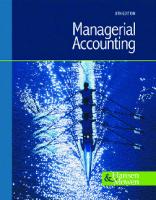
- Author / Uploaded
- Judith Read
- Mary Lea Ginn
Records Management, 8th Edition
AUTHORS Judith Read Instructor & Department Chair Computer Information Systems Portland Community College Portland, Oreg
5,514 3,009 5MB
Pages 417 Page size 576 x 720 pts
Recommend Papers
File loading please wait...
Citation preview
AUTHORS Judith Read Instructor & Department Chair Computer Information Systems Portland Community College Portland, Oregon
Mary Lea Ginn, Ph.D. Coordinator, Institutional Review Board Union Institute & University Cincinnati, Ohio Editorial Consultant Cincinnati, Ohio
CONTRIBUTING AUTHORS Virginia A. Jones, CRM, FAI VAJones Associates Newport News, Virginia
Dianne S. Rankin Educational Media Development Monticello, Kentucky
Australia • Brazil • Japan • Korea • Mexico • Singapore • Spain • United Kingdom • United States
Copyright 2010 Cengage Learning. All Rights Reserved. May not be copied, scanned, or duplicated, in whole or in part.
Records Management, Eighth Edition Judith Read and Mary Lea Ginn VP/Editorial Director: Jack W. Calhoun
Marketing Manager: Valerie A. Lauer
VP/Editor-in-Chief: Karen Schmohe
Marketing Coordinator: Kelley Gilreath
Acquisitions Editor: Jane Phelan
Manufacturing Coordinator: Charlene Taylor
Project Manager: Penny Shank
Art Director: Linda Helcher
Production Project Manager: Darrell E. Frye
Photo Researcher: Darren Wright
COPYRIGHT © 2007 South-Western, a part of Cengage Learning. Printed in the United States of America 1 2 3 4 5 09 08 07 06 Student Edition ISBN-13: 978-0-538-97448-6 ISBN-10: 0-538-97448-6 Student Edition with CD ISBN-13: 978-0-538-72956-7 ISBN-10: 0-538-72956-2
Consulting Editors: Dianne S. Rankin Carol L. Ruhl Production House: Graphic World Inc. Printer: RR Donnelley Willard, OH Internal and Cover Designer: Diane Gliebe Cover Images: ©Getty Images
ALL RIGHTS RESERVED. No part of this work covered by the copyright hereon may be reproduced or used in any form or by any means—graphic, electronic, or mechanical, including photocopying, recording, taping, Web distribution or information storage and retrieval systems, or in any other manner—without the written permission of the publisher. For permission to use material from this text or product, submit a request online at www.cengage.com/permissions. For more information about our products, contact us at: South-Western 5191 Natorp Boulevard Mason, Ohio 45040 USA
Copyright 2010 Cengage Learning. All Rights Reserved. May not be copied, scanned, or duplicated, in whole or in part.
Preface RECORDS MANAGEMENT, Eighth Edition, continues the strong tradition of serving as an introduction to the increasingly comprehensive field of records and information management. New information continues to grow at a rapid rate, which causes the field of records and information management to be in a state of flux. This edition emphasizes principles and practices of effective records management for manual and electronic records systems. This approach offers practical information to students as well as to professionals at managerial, supervisory, and operating levels. Emphasis is placed on the need to understand the changes occurring with the volume of information, the need for compliance to government regulations, and advances in technology. As a text for students in post-secondary institutions, RECORDS MANAGEMENT, Eighth Edition, may be used for short courses or seminars emphasizing filing systems or longer courses such as quarter or semester plans. Basic manual systems concepts and the concepts needed for understanding electronic records storage and retrieval methods are discussed and applied. As a reference book, this latest edition of RECORDS MANAGEMENT serves several purposes. It presents sound principles of records and information management that include the entire range of records—paper, image records, and electronic media used in computerized systems. Although the key management functions as they relate to records management are introduced, emphasis is placed upon control for ensuring that the records system achieves its stated goals. Professionals who direct the operation of records systems will find this edition to be valuable because the rules in the textbook agree with the latest standard filing rules presented by ARMA International.
How the Text Is Organized The text consists of four parts organized into 12 chapters. ■
■
■
Part 1 introduces the student to the expanding area of records management. Part 2 centers on alphabetic storage and retrieval methods for manual and electronic systems. Transferring records from active storage according to established records retention schedules is also discussed. Part 3 presents a detailed description of adaptations of the alphabetic storage and retrieval method; namely, subject, numeric, and geographic storage methods.
Copyright 2010 Cengage Learning. All Rights Reserved. May not be copied, scanned, or duplicated, in whole or in part.
iv
Preface
■
Part 4 covers records and information management technology, which includes an update of image systems and the technology that integrates the computer with other automated records systems. In addition, the need for controlling paperwork and electronic records problems are reviewed for both large and small offices. The records audit, the records and information manual, knowledge management, and developing and implementing a disaster recovery plan conclude the discussion of a comprehensive records and information management program.
Key Features The eighth edition of RECORDS MANAGEMENT was completely redesigned for easy reading and maximum retention. ■
■
■
■
Each chapter begins with easy-to-understand learning objectives so you know exactly what your goals are as you read and study the chapter. Key terms are bolded the first time they are used and conveniently listed at the end of the chapter and in the glossary for improved vocabulary building. Eye-catching, full-color illustrations and photos provide realistic examples of filing supplies, file drawers, filing systems, and electronic records. Marginal notes in the form of questions lead you through the major points in each chapter. 34 Part 2: Alphabetic
CHAPTER
Storage and Retr ieval
Indexing Indexing
2
xing Rules 1-4 Alphabetic Inde
Learning
Objectiv
es
onal and and arrange pers ers and 5. Index, code, with single lett business names ns. atio abbrevi res. tic filing procedu 6. Apply alphabe ferences consistently. arrange cross-re es. and and l are ona Prep 7. business nam and arrange pers r of 2. Index, code, for personal and in indexing orde business names records. 8. Sort paper units. e records. or words tion in databas and arrange min 9. Find informa 3. Index, code, business names. and symbols in onal and and arrange pers and 4. Index, code, with punctuation business names . ives sess pos
rules in need for indexing and the 1. Explain the age of records alphabetic stor rules following these importance of
HABETIC NEED FOR ALP
How do business records help decision makers?
What is indexing ?
What is a filin g segment?
is the mental proc ess of determining which a record the filing segment is to be stored (or name) by and the placing that follows a or listing of item particular syste s in an order m. The filing segm record is stored ent is the nam and requested. e by which a In alphabetic stor means determining age, the process of inde the name that is xing to be used in filin easily recognized. g. The name is On corresponde usually nce, the name may on a record. In the letter shown appear in various in Figure 2.1, the places the person to who filing segment is m the letter is add the name of ressed. Because accurate indexing is nece ssary for quick is extremely impo retrieval, the inde rtant. Careful, xing step accurate indexing ing step in the is perhaps the mos storage procedur e. In an alphabet t exactof the right nam ic arrangement, e by which to stor the selection e (the filing segm will be found quic ent) means that kly when it is need the record ed. If the wrong time will be wast ed trying to loca name is selected, te the record whe much When selecting n it is eventually a filing segment, requested. choose the nam asking for the e most likely to record, usually be used in the most importa nt one. You will learn more
ORDER
organization. memory of an rds serve as the s records help proin Chapter 1, reco business. Busines As you studied ed. To store nization conduct need orga is it an n help whe Records also t information must be used. ers with the righ storing method vide decision mak type of filing or in which ient way, some describes the way od, meth ge records in an effic d a stora s text presents alsometimes calle filing cabinet. Thi A filing method, Alphabetic ainer, such as a age. cont a stor in of s ed raphic method records are stor 8, numeric numeric, and geog age in Chapter phabetic, subject, to 7, subject stor 10. The most com d in Chapters 2 age in Chapter storage is discusse geographic stor and 9, pter storage in Cha nged acic. arra abet rds alph reco is ing hod mon filing met a method of stor knows the filing method is right? Everyone The alphabetic . Sounds simple, not that simple. rs of the alphabet abetic filing is cording to the lette tly accurate alph isten cons , ever alphabet. How
Filing Segment
Figure 2.1 Filin g Segment on a Letter
Copyright 2010 Cengage Learning. All Rights Reserved. May not be copied, scanned, or duplicated, in whole or in part.
Preface
NEW!
NEW!
■
■
■
a personal records management feature, provides valuable information about managing personal records. My Records,
Part 2: Alphabetic
My Records Theft? What is Identity be rise. Might you theft is on the Beware! Identity n victims per year? ated 7 to 10 millio one of the estim ation pieces of inform stor obtains key and in which an impo license number, a serious crime ) and/or driver’s imperIdentify theft is ity number (SSN information to as your Social Secur Impostors use this le beabout you, such her personal gain. a time as possib or short his as for in ation as they can uses your inform as much money ing . spend ation s, nt inform sonate their victim and identifying existing credit accou er victim’s name thief steals your or simfore finding anoth occurs when a actual credit card ver identity theft using either the Account takeo cts and services purchases produ identifytion date. information and your SSN and other er and the expira uses numb thief nt a not are accou when s ply the ation fraud identity theft occur . Victims of applic to Application fraud nts in your name ents are mailed to open new accou hly account statem ing information because the mont it for some time than the likely to learn about impostor. liable for no more by the ng cleari and banking fraud years credit an address used or of s months holds victim d ity theft can spend Federal legislation rtunities, 1be refuse victims of ident loss. However, also lose job oppo thief. first $50 of the s. Victims may by the identity s and credit record crimes committed > (actheir good name for ed eft/html arrest gov/idth or even get www.consumer. ID Theft,









